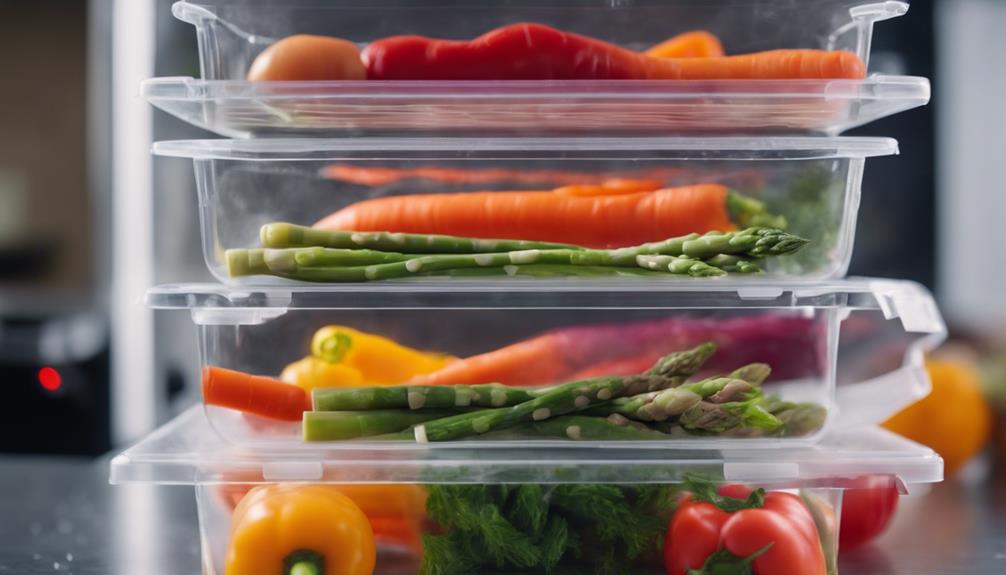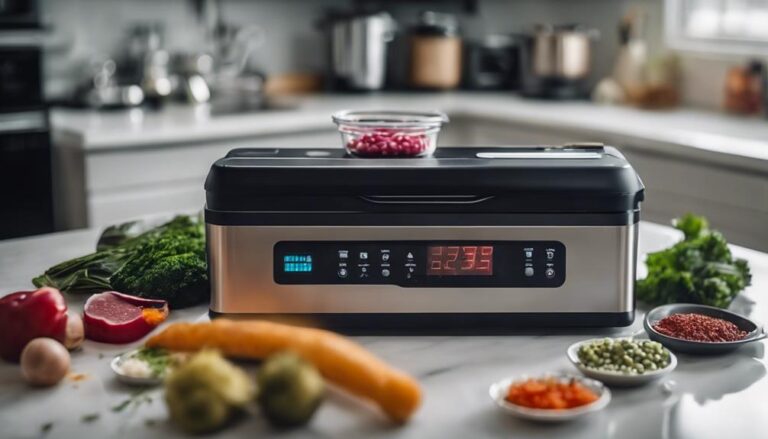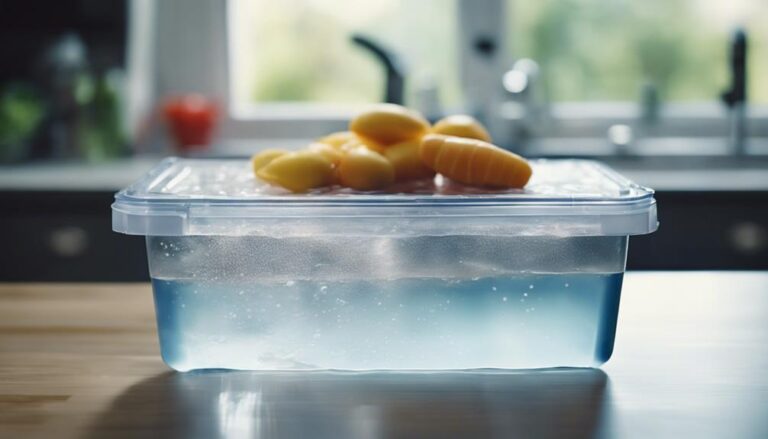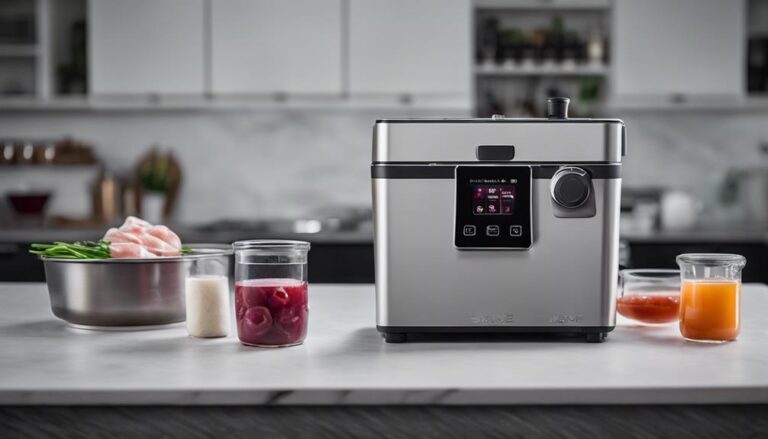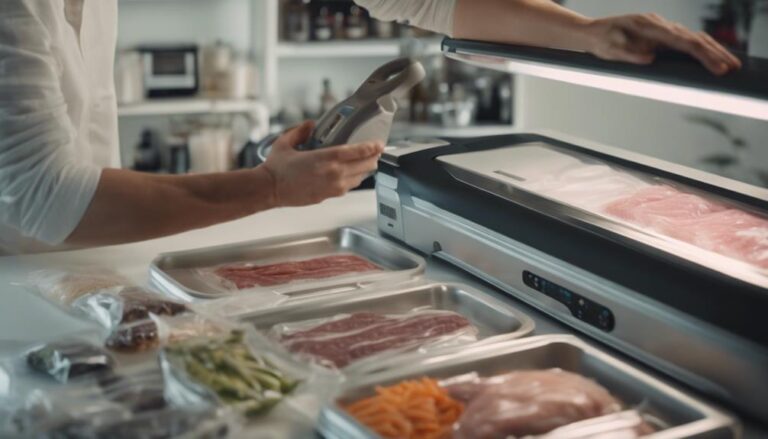Sous Vide Vegetables: Exploring Textures and Flavors
Discover a world of textures and flavors with sous vide vegetables. Achieve precise cooking with enhanced nutrition. Seal in flavors for a convenient and consistent experience. Choose sturdy veggies like asparagus and broccoli. Experiment with different textures and prep methods. Season with herbs and spices for an explosion of taste. Pair vegetables creatively for unique combinations. Enhance nutrients and colors on your plate. Elevate your culinary skills with sous vide cooking. Get ready to reveal a whole new level of culinary adventure.
What You Will Learn Here
- Experiment with cooking times and temperatures for varied textures
- Adjust parameters to control firmness or tenderness
- Season vegetables before sous vide for enhanced flavors
- Pair vegetables creatively with complementary flavors
- Retain up to 90% of nutrients with sous vide for nutritional benefits
Benefits of Sous Vide Vegetables
Uncover the enhanced nutritional benefits of sous vide vegetables through precise cooking techniques that maintain flavor and nutrients. When you opt for sous vide your vegetables, you're guaranteeing that the nutrients are preserved due to the lower cooking temperatures maintained. The sealed environment in sous vide not only conserves the nutrients but also enhances the flavor retention in the vegetables, resulting in a more delicious and nutritious meal.
The convenience of sous vide cooking is unparalleled when it comes to vegetable preparation. With minimal attention required, you can achieve consistent results every time, eliminating the guesswork often associated with traditional cooking methods. The precision cooking of sous vide ensures that your vegetables are cooked to perfection, enhancing their flavors and textures.
Bid farewell to overcooked or undercooked vegetables – with sous vide, you can enjoy perfectly cooked vegetables every time, making your meals more enjoyable and nutritious.
Selecting the Right Vegetables
When choosing vegetables for sous vide cooking, consider the texture you desire and opt for sturdy options like asparagus and broccoli that hold up well.
Select flavorful vegetables such as peppers, mushrooms, or zucchini to enhance the taste of your dishes.
Remember that different vegetables require specific cooking times and temperatures to achieve the best results in sous vide preparation.
Vegetable Texture Selection
For achieving the ideal texture in your sous vide vegetables, careful selection of the right vegetables is paramount. Root vegetables such as carrots, potatoes, and beets, known for their sturdy texture, are excellent choices for sous vide cooking.
Sturdy vegetables like asparagus, broccoli, and green beans also hold up well during the sous vide process, maintaining their texture. It's important to keep in mind that different vegetables may require varying cooking times and temperatures to reach the desired consistency.
Properly selecting your vegetables is vital in achieving the perfect texture in your sous vide dishes. By choosing the right vegetables, you establish the groundwork for exploring a wide range of textures and flavors in your sous vide creations.
Flavorful Vegetable Choices
Selecting the correct vegetables for your sous vide cooking is crucial to guaranteeing ideal texture and flavor in your dishes. Opt for robust vegetables like carrots, potatoes, and beets, known for their sturdy nature.
Resilient options such as asparagus, broccoli, and green beans maintain their texture and flavor well during sous vide cooking. Keep in mind, different vegetables have varying cooking requirements, so choose wisely to achieve the desired textures.
Successful outcomes in sous vide cooking rely on selecting vegetables that can withstand precise temperature control and prolonged cooking times. By making informed choices about which vegetables to use, you can ensure that your sous vide dishes are bursting with delicious flavors and perfectly cooked textures.
Preparing for Sous Vide Cooking
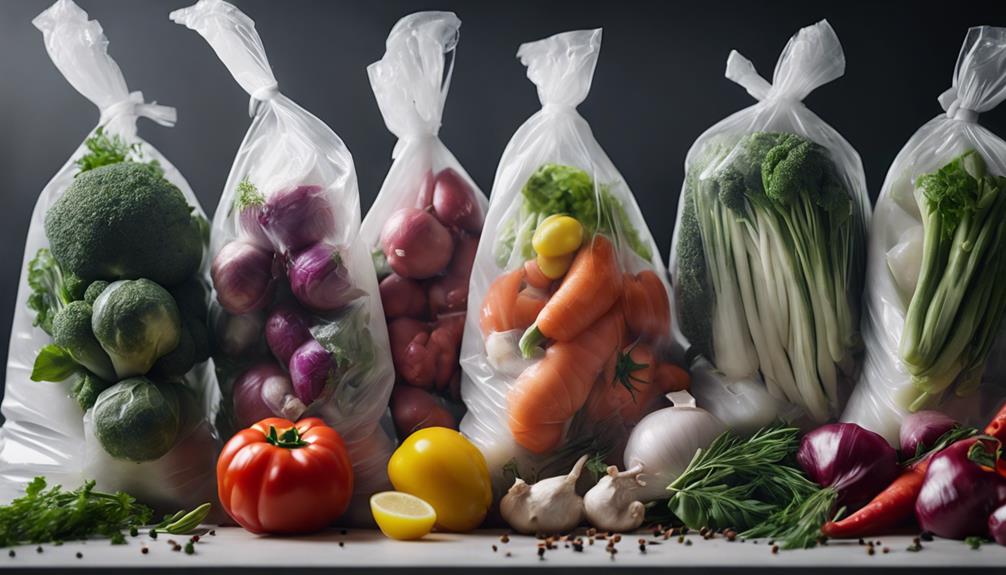
To guarantee outstanding outcomes in your sous vide cooking, start by washing and peeling vegetables like carrots, potatoes, and beets. This initial step ensures cleanliness and sets the stage for excellent results. Cutting the vegetables into uniform pieces is essential for promoting even cooking and maintaining consistent textures. Enhance the flavors of your vegetables by adding herbs, spices, or aromatics to the vacuum-sealed bags. This infusion of additional ingredients will elevate the taste profile of your dishes.
Properly preparing your vegetables before sous vide cooking is pivotal in ensuring they're ready for the precise temperature-controlled process. By vacuum-sealing the vegetables with the added herbs, spices, or aromatics, you create a sealed cooking environment that enhances both flavors and textures. This meticulous preparation sets the foundation for a delicious and well-executed sous vide dish that you can proudly serve to your guests.
Achieving Optimal Textures
To achieve ideal textures in your sous vide vegetables, it's crucial to experiment with different cooking times and temperatures. By controlling the consistency and balance between flavor and texture, you can customize your vegetables to your preferences.
Keep in mind these tips for maintaining a perfect crunch or tenderness in your sous vide creations.
Texture Experimentation Tips
For achieving prime textures when experimenting with sous vide vegetables, vary your cooking times to control the firmness or tenderness of your veggies. Here are some tips to help you enhance the textures of your vegetables:
- Experiment with Cooking Times: Longer times result in softer textures, while shorter times maintain crunch.
- Adjust Temperatures: Control the firmness or tenderness by adjusting the cooking temperature.
- Consider Pre-Searing: Try pre-searing your vegetables before sous vide for added texture contrast.
- Use Finishing Sear: Finish by giving your vegetables a sous vide finishing sear to caramelize and enhance their texture.
Consistency Control Methods
As you explore sous vide vegetables, mastering consistency control methods becomes crucial to achieving ideal textures in your culinary creations.
With sous vide, you have precise control over cooking temperatures, allowing you to achieve perfect textures without the risk of overcooking. Consistency control guarantees that your vegetables retain their natural flavors and nutrients, enhancing the dining experience for those you serve.
Through experimentation with different cooking parameters, you can tailor the textures of your vegetables to suit your preferences. By honing your consistency control skills in sous vide, you can consistently deliver perfectly cooked vegetables with the desired textures every time, providing a delightful culinary experience for your guests.
Flavor-Texture Balance Insights
Achieving ideal textures in sous vide vegetables requires a delicate balance between flavor and texture profiles, ensuring a harmonious culinary experience for your diners. When aiming for perfect textures, consider the following insights:
- Experiment with different cooking times to find the perfect balance between firmness and tenderness.
- Adjust temperature settings based on the vegetable type to retain desired textures like crisp-tender or velvety.
- Utilize the precise control offered by the sous vide method to achieve consistent results without vegetables becoming mushy.
- Explore varying cooking parameters to discover the ideal texture balance that suits your preferences and elevates the flavor-texture harmony of your sous vide vegetables.
Flavor Infusion Techniques
Enhance the flavor of your sous vide vegetables by infusing them with herbs, spices, or aromatics before vacuum-sealing. By adding ingredients like garlic, thyme, or rosemary to your vegetables before sealing them in the bag, you guarantee that the flavors penetrate deeply into the vegetables during the cooking process. Vacuum-sealing helps the vegetables absorb the seasonings, resulting in a more intense flavor profile.
Aromatic elements like garlic, thyme, and rosemary can greatly enhance the taste of your sous vide vegetables, providing a robust and savory experience for those you serve.
Experimenting with different combinations of herbs, spices, and aromatics allows you to create unique and delicious vegetable dishes tailored to your preferences. Proper infusion techniques are essential to ensuring that your vegetables are well-seasoned and bursting with flavor after the sous vide cooking is complete. So, don't be afraid to get creative with your flavor infusion process to elevate the taste of your sous vide vegetables to a whole new level.
Seasoning and Marinades
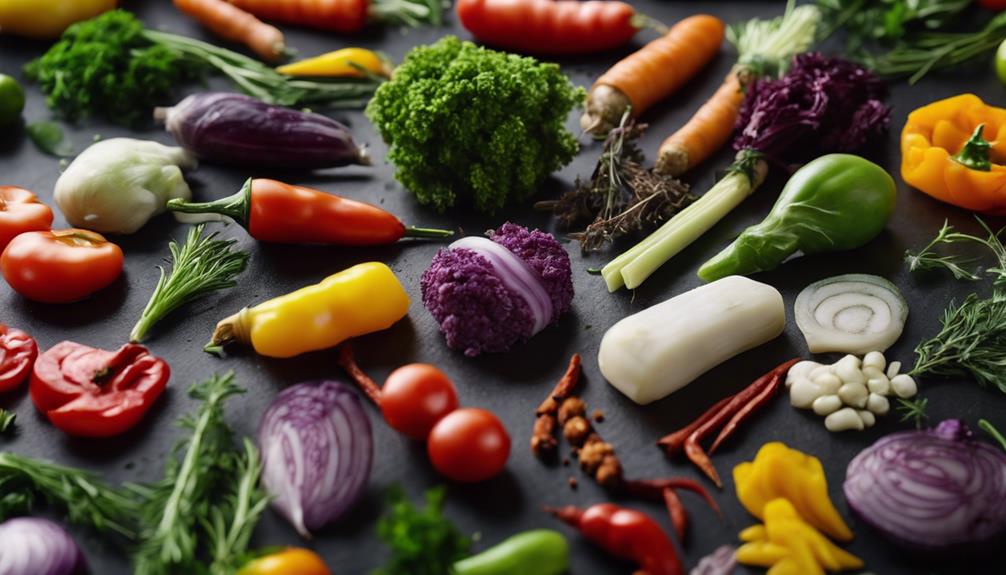
Flavoring your vegetables before sous vide cooking can greatly enhance their taste profile. To make your sous vide vegetables truly standout, consider the following tips:
- Seasoning: Before sealing your vegetables in the sous vide bag, generously season them with salt, pepper, and any other desired spices for a flavorful base.
- Herbs: Incorporate aromatic herbs like rosemary, thyme, or garlic into the bag with your vegetables to infuse them with delightful flavors during the cooking process.
- Citrus Zest: Adding citrus zest such as lemon or orange can brighten up the vegetables and provide a zesty kick to the dish.
- Marinades: Experiment with marinating your vegetables in ingredients like soy sauce or balsamic vinegar before cooking sous vide to introduce complex flavors and tenderize the vegetables.
Creative Sous Vide Pairings
Get ready to elevate your sous vide vegetable game with innovative pairings that will tantalize your taste buds.
Pairing sous vide asparagus with a sprinkle of lemon zest and a generous shaving of parmesan creates a vibrant and zesty flavor combination that will brighten up any dish.
For a sweeter touch, try combining sous vide carrots with a drizzle of honey and a sprinkle of fresh thyme to enhance the natural sweetness and earthy notes of the carrots, creating a delightful balance of flavors.
If you're in the mood for something with a kick, experiment with sous vide broccoli seasoned with garlic and chili flakes for a delicious burst of heat and savory undertones.
To add a tangy and aromatic profile to your dish, infuse sous vide green beans with a splash of balsamic vinegar and some sautéed shallots.
These creative sous vide pairings will take your vegetable dishes to a whole new level of flavors and textures.
Enhancing Nutritional Value
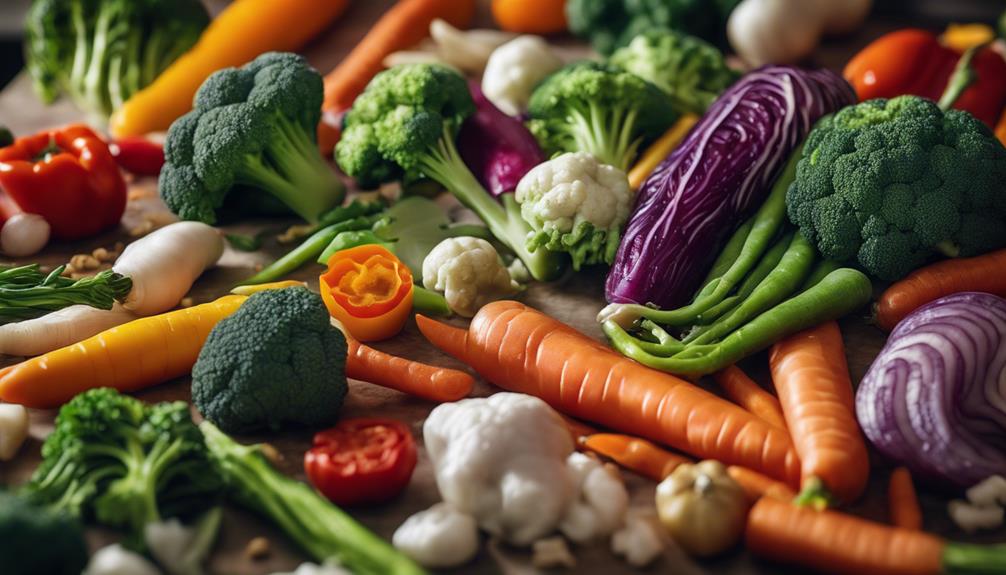
To further optimize the nutritional benefits of your sous vide vegetable creations, consider the ways in which sous vide cooking uniquely preserves and enhances the nutrient content of the ingredients.
Here are four key ways sous vide enhances the nutritional value of vegetables:
- Retains up to 90% of Nutrients: Sous vide cooking helps retain a significant amount of nutrients in vegetables compared to traditional cooking methods.
- Preserves Vitamins, Minerals, and Antioxidants: Cooking vegetables at precise temperatures in sous vide preserves essential vitamins, minerals, and antioxidants.
- Sealed Environment: The sealed environment of sous vide cooking prevents nutrient loss through leaching into cooking water, ensuring maximum nutrient retention.
- Enhances Bioavailability: Sous vide enhances the bioavailability of nutrients in vegetables, making them more easily absorbed by the body for increased health benefits.
Serving and Presentation Ideas
Enhance the visual appeal of your sous vide vegetable dishes by arranging them in a colorful and appealing manner on the plate. Drizzle with a balsamic reduction or herb-infused oil to add a pivotal touch to the dish. For an extra pop of color and flavor, garnish with fresh herbs or toasted nuts, creating a delightful contrast in textures. Consider serving alongside a creamy dip or tangy vinaigrette to complement the flavors of the vegetables and provide a satisfying dip option.
Experiment with different plating techniques to elevate your presentation, such as stacking the vegetables in a creative manner or layering them for a visually stunning effect. The addition of these elements not only enhances the overall look of the dish but also adds depth to the dining experience. Remember, the art of plating is just as essential as the cooking process itself when it comes to sous vide vegetables.
Frequently Asked Questions
How Should You Cook Vegetables to Maintain Color Texture and Flavor?
To maintain color, texture, and flavor of vegetables, you should consider different cooking methods. Sous vide is excellent for precision. Steaming, blanching, roasting, grilling, stir-frying, sautéing, microwaving, pressure cooking – each has its secrets for delicious veggies. Choose wisely!
How Can You Retain the Natural Flavour and Texture of Vegetables During Cooking?
To retain the natural flavor and texture of vegetables during cooking, consider using sous vide over steaming. Enhance taste with proper seasoning techniques, blanching benefits, slow cooking, and marinating tips. Control temperature, vacuum seal, pair veggies thoughtfully, manage time, and taste test for perfection.
How Do You Make Sous Vide More Flavorful?
To make sous vide more flavorful, enhance taste by infusing herbs, experimenting with spices, balancing flavors, adding aromatics, creating marinades, incorporating seasonings, playing with textures, developing umami, and exploring pairings. Elevate your dishes with these techniques.
Is It Worth It to Sous Vide Vegetables?
Is it worth it to sous vide vegetables? Absolutely! You'll save time, retain nutrients, infuse flavors, get consistent results, minimize mess, enjoy enhanced taste, have versatile cooking options, savor tender veggies, customize seasonings, and find preparation easy.
Conclusion
Now that you've explored the world of sous vide vegetables, you can elevate your culinary skills by experimenting with different textures and flavors.
By selecting the right vegetables, preparing them properly, and using flavor infusion techniques, you can create delicious and nutritious dishes that are sure to impress.
With some creativity and a touch of finesse, you can take your sous vide cooking to the next level and enjoy a whole new domain of culinary possibilities.
Happy cooking!
